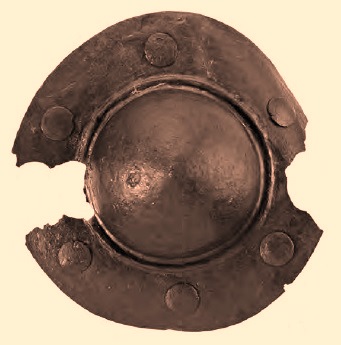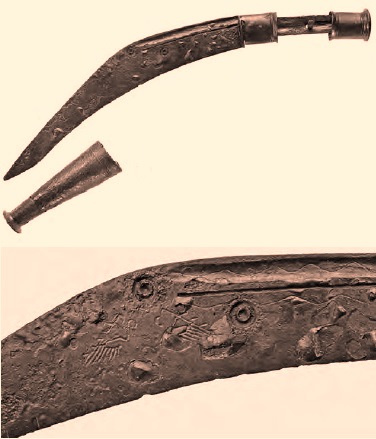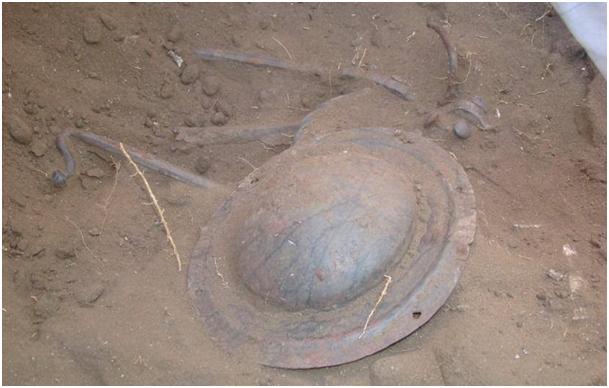Mac Congail
“One must have evidence, because knowledge is not mere true belief”.
(Butcharov. The Concept of Knowledge)
Perhaps the most iconic of Celtic Iron Age weapons, in its classic form the Celtic shield consisted of an ovoid shield board with a long, spindle-shaped umbo with a spine extending vertically along the shield board. Both Greek and Roman art depicted the oval shield with the spindle boss as an identifying feature of the ‘barbarian’ Celt’s shield (see ‘Shield Coins’ article). Since the main components of these shields are organic, surviving archaeological evidence is limited.
Such shields are known from approximately the 6th century BC to the early centuries AD through artwork, scattered remains of fittings, and in a few rare instances, wholly preserved shields, such as those from the site of La Têne itself.

The earliest evidence for Celtic shields on the territory of today’s Bulgaria dates to the second half of the 4th c. BC when warriors on the friezes of the Kazanlak / Seuthopolis tomb are depicted with the distinctive oval Celtic shields (Domaradski 1984, Mac Congail 2008, Emilov 2010). Celtic presence in this area at this early stage is confirmed by La Têne B artifacts from the villages of Ivanski, Malomir, Sveschtari (Dom. 1984:134, 138; Mac Congail 2010:51) and from the Schumen/Veliko Tarnovo areas (see ‘New Material 1 + 2’ articles). Depictions of Celtic oval shields also appear on a number of coins minted by the Celtic ‘Tyle’ state in eastern Thrace in the 3rd c. BC (See ‘Shield Coins’ article).
Such shields have been registered in eastern Bulgaria at sites such as Kamburovo (Targovischte region – Novo Mesto 169 type) (Domaradski 1984; Emilov 2010), the Celtic warrior burials at Kalnovo (Schumen region) (Atananassov 1992; Megaw 2004), and in the chieftains burials at Sashova and Fomus tumuli near the Shipka pass (Manov 2010). Further La Têne shields, but dating to the Roman period, have been found at the Taja site, to the west of Sevtopolis (See below).
As with finds of La Têne swords, scabbards, chainmail etc., the majority of Celtic shields found in Bulgaria have been discovered in the west of the country. At Gorna Malina in the Sofia region a Celtic shield of the Karaburma type has been registered (Emilov 2010). Also from the Gorna Malina area (Bailovo) comes the earliest Celtic sword from Bulgaria, which dates to the La Têne B2 period (see ‘Sacrificial daggers, Swords and Settlements’ article). To the southwest of the Bulgarian capital an oval Celtic shield was found in 1989 in a burial at Dolna Koznitza (Pernik region) which had been disturbed by ‘treasure hunters’. Associated with this Celtic shield was an inscribed Macedonian shield, suggesting that the burial is related to the first phase of Celtic expansion into the area at the end of the 4th / beginning of the 3rd c. BC. (Manov, Staikova 1992).
Also noteworthy from the aforementioned Dolna Koznitza site is a bronze frontlet and other artifacts executed in the distinctive Celtic Plastic style common from the 4th c. BC. The frontlet with a 3 dimensional head above opposing rams heads, as with other Celtic works of art from this period found in Bulgaria, such as the Mezek chariot attachments or the golden Janus heads from Schumen, conforms exactly to the definition of this Celtic art style – ‘protruding, non-representational relief ornament cast in bronze and demonstrating a particular type of abstraction of human and animal heads’ (Megaw 2001: 139, 140-141,144).

Celtic Bronze frontlet from Dolna Koznitza (Pernik region, Bulgaria)
NORTHWESTERN BULGARIA
As with the majority of La Têne material dating to the II – I c. BC, it is northwestern Bulgaria which has yielded the majority of finds of Celtic shields. Novo Mesto 169 type shields have been found at Koynare (Pleven reg.) and at Smochan and Dojrentsi in the Lovech region (Emilov 2010; on other Celtic material from these sites see ‘Sacrificial daggers, Swords and Settlements’ and ‘Chainmail’ articles) In the Montana/Vratza regions Celtic shields (umbos), all accompanied by La Têne D swords of the Belgrad 3/Mokronog 5-6 type (Torbov 1997, 2000), and other La Têne material consistent with similar Scordisci burials across the border in Serbia, have been recorded at Kriva Bara (Montana region), where the recent publication of La Têne ceramic confirms Celtic settlement until at least the 1st c. AD (Vagalinski 2007), as well as at Dobruscha, Varbeschnitza, Galiche and Tarnava in the Vratza region (Torbov op cit).
Particularly interesting is the Germanic (Bastarnae) influence in the construction of the Tarnova shield (Domaradski 1984: 144), which may relate this burial to the battles between the Roman forces of Crassus and his ‘Dacian’ allies and the Bastarnae/Scordisci in 29/28 BC. The presence of the Bastarnae in this area of northern Bulgaria is also confirmed by other archaeological evidence (e.g. from the Panagurischte Kolonii site – see ‘Sacrificial daggers, Swords and Settlements’ article), topographical traces (see ‘Celtic Settlements in Northern Bulgaria’ article), as well as extensive finds of Bastarnae coins of the Huşi Vovrieşti type found in north-central and north-western Bulgaria (See Numismatics section, and Mikolajczyk 1984). Thus, while the majorty of Celtic material from this part of Bulgaria is connected to the Scordisci tribes (Serdi, Meldi, Artacoi), some of it, such as the Tarnova burial, may be associated with the Celto-Germanic Bastarnae tribes (see Bastarnae article).
Besides the aforementioned burials, Celtic Novo Mesto 169 type shields are also depicted on the silver Scordisci treasures from Galiche and Jakimovo (Emilov op. cit.). At the latter site recent publication of La Têne ceramic, similar to that found at Kriva Bara and underneath the Roman Castra Martis at Kula in the Montana region, confirms Celtic settlement at that site until at least the 1st c. AD. (Vagalinski 2007). The Scordisci treasures from Jakimovo and Galiche will be dealt with separately.

Depiction of a Celtic (Scordisci) chieftain on a sliver/gilt plate from the Jakimovo treasure (Northwestern Bulgaria) II – I c. BC
TAJA
The latest Celtic shields found on the territory of today’s Bulgaria have been discovered at the Atanasza site near the village of Taja in the Balkan mountains. Celtic presence in this area of the central Balkans from the 3rd c. BC until the 3rd / 4th c. AD is testified to by a large amount of Celtic material from the Sevtopolis/Kazanlak area, as well as from the villages of Kran, Dolno Sahrane, and from the Shipka Pass area to the northwest of Sevtopolis (e.g. Sashova and Fomus tumuli) (Manov 2010). This material is to be related to the Celtic Artacoi tribe who inhabited this area from the late Iron Age until the Early Christian period (see Artacoi article – forthcoming).
At the Taja site two La Têne shield umbos were found in ‘rich’ warrior burials (Tumulus # 3, burial # 1 + 3; other burials yielded typically only ceramic or ceramic and a single spearhead). The shield umbo from burial # 3 was associated with a Middle La Têne sword and scabbard (Group B according to De Navarro’s classification) (Domaradski 1993), while the shield itself is characteristic for the La Têne D period, similar to the aforementioned examples from northwestern Bulgaria. Associated ceramic dates this burial to the 1st / 2nd c. AD. Burial # 1 yielded a further La Têne iron shield umbo, as well as a La Têne sword and accompanying scabbard of the Noric tradition (Werner 1977; Domaradski op cit.). Both the Celtic sword and shield show modifications based on Roman models of the 1st / 2nd c. AD, while the burial itself dates to the late 2nd / 3rd c. AD (Domaradski op cit). Weaponry and other material from the site were killed in the distinctive Celtic fashion, a custom also to be observed in this area at Celtic burials from Sevtopolis, and at sites such as Skalsko and Chervenvruh (see ‘Killing the Objects’ article) from the 3rd c. BC until the Early Christan period (3rd / 4th c. AD).
Settlement at the Taja site began not earlier than the late 2nd / 1st c. BC, i.e. within the framework of the Scordisci Wars, and the movement of a Celtic population into this mountainous area during this period is to be related to the Roman advance into western Thrace. Two separate Roman campaigns were undertaken against the Celtic Artacoi tribe in this area, in 29/28 BC by Crassus and in 23/24 AD by Sabinius (see ‘Artacoi’ article – forthcoming), but archaeological evidence from the central Balkan mountains of Bulgaria indicates the survival of a Celtic population in this area into the Early Christian period.
Map Sh. 1

Distribution of Recorded Celtic Shields in N.W. Bulgaria
* Provisional (April 2012). Map includes only La Têne weaponry, other Celtic material from this area will be dealt with separately
** Celtic coinage does not include Celtic Paeonia issues or Bastarnae coins
Literature
Alexandrov G. (1984) Montana-eine thrakisch-römisch Stadt”, in Dritter Internationaler Thracologischer Kongress, Sofia, 1984, p. 218-231.
Атанасов Г., Съорьжени от III– II в. Пр. н.е. от околностите на с. Кълново, Шуменско – ИИМШ,VII, 1992, с. 5-44.
Christov Iv., Rock Sanctuaries of Mountain Thrace. V. Tarnovo. 1999
Домарадски М. (1984) Келтите на Балканския полуостров. София.
Домарадски М., Могилен Некропол в м. Атанасца при с. Тъжа, In: Първи Международен Симпозиум “Севтополис”, Надгробните Могили в Югоизточна Европа. Казанлък, 4-8 юни 1993 г., Pp. 267 – 306.
Домарадски М. и колектив. Паметници на тракийската култура по горното течение на река Места – Разкопки и проучвания, кн. XXVI, 1999, 15 – 19
Emilov J. (2007) La Tene finds and the indigenous communities in Thrace. Interrelations during the Hellenistic period. – Studia Hercynia 11, 57-75
Emilov J. (2010) Ancient Texts on the Galatian Royal Residence of Tylis and the Context of La Tene Finds in Southern Thrace. A reappraisal. In: In Search of Celtic Tylis in Thrace (III c. BC) Proceedings of the Interdisciplinary Colloquim arranged by the National Archaeological Institute and Museum at Sofia and the Welsh department, Aberystwyth University. Sofia 2010. 67-88.
Gerov B. (1967) Untersuchungen über die westthrakischen Länder in römischer Zeit. II Teil – Annuaire de l’Université de Sofia. Faculté des letters. Tome I. XI, 1. P. 1-102.
Gerov B. (1968) Keltische Spuren in Westthrakien. In: Studien zur Geschichte un Philosophie des Altertums. Akademiai Kiadó, Budapest. P. 3349 – 355
Кацаров Г. (1919) Келтите в стара Тракия и Македония, СИБАН 18, кл. ист. Фил. 10, София, 1919, 41-80
Кацаров Г. (1926) България в древността. Историко-археологически очерк. Популярна археологическа библиотека, No. 1. София
Lazarov L. The Celtic Tylite State in the time of Cavaros. In: In Search of Celtic Tylis in Thrace (III c. B.C.). Proceedings of the Interdisciplinary Colloquium arranged by the Archaeological Institute and Museum at Sofia and the Welsh Department, Aberystwyth University held at the National Archaeological Institute and Museum. Sofia 2010. P. 97 – 114.
Манов М., Стайкова Л. (1992) Следи от Надпис вьрху бронзов щит от Тракия. In: Нумизматика и Сфрагистика 1-2р 1992. 23 – 26.
Mac Congail B. (2007) Belgae Expansion into South-Eastern Europe and Asia-Minor (4th – 3rd c. BC) In: PRAE, In honorem Henrieta Todorova. P. 295 – 302. Sofia
Mac Congail B. (2008) Kingdoms of the Forgotten. Plovdiv (attached Pdf.)
Mac Congail B., Krusseva B. (2010) The Men who Became the Sun – Barbarian Art and Religion on the Balkans. Plovdiv
Megaw V. and Megaw R. (2001) Celtic Art from its Beginnings to the Book of Kells (Revised and Expanded edition) Thames and Hudson.
Megaw J.V.S. (2004) In the Footsteps of Brennos? Further Archaeological Evidence for Celts in the Balkans. In: Hӓnsel B., Studenikova E. (eds.) Zwischen Karpaten und Ӓgӓis. Neolithikim und ӓltere Bronzezeit. Gedenkschrift für Viera Nemejcova–Pavukova. Rahden/Westf. 93 – 107.
Mikolajczyk A. The Transcarpathian finds of Geto-Dacian coins. In: Archaeologia Polona XXIII 1984. P. 49 – 66
Todorović J. (1972) Praistorijska Karaburma, I, Beograd.
Торбов Н. (1997) Криви тракийски ножове от III пр. Хр. – I в. открити в сиверосападна България. In: Исвестия на музеите в сиверосападна България. т. 25. 1997.
Торбов Н. (2000) Мечове от III- I в. пр. Хр. открити в сиверосападна България. In: Исвестия на музеите в сиверосападна България. т. 28. 2000.
Torbov N. (2005) Curved Thracian Knives from North-Western Bulgaria, in: Heros Hephaistos, Studia in Honorem Liubae Ognenova – Marinova. Veliko Tarnovo, 2005. P. 358 – 367
Werner J. (1977) Spatlatene schwerter norischer herkunft (B) Ausklang der laten Zivilisation und Anfange der germanischen Besiedelung im mittleren Donaugebiet. Bratislava. p. 367 – 401
Vaglinski L. F. (2002) Burnished Pottery from the first century to the beginning of the seventh century AD from the region of the lower Danube (Bulgaria) Sofia.
Vagalinski L. F. (2007) Celtic Pottery in Northern Bulgaria. In: The Lower Danube in Antiquity (VI c. B.C. – VI c. A.D.). International Archaeological Conference. Bulgaria – Tutrakan, 6-7.10.2005. p. 72-83. Sofia.


































